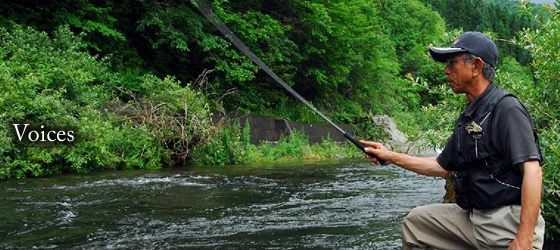証言2

Yvon Chouinard’s Articles 3
Lessons from the Tenkara
In Japanese, the word Tenkara means “from the heavens.” It could be
a prescient name for this simple and ancient technique, as it just might be
salvation for the dying fly fishing industry. Let me explain.
I’ve been disappointed lately by what I’m seeing as the “state of the
art” of fly fishing. It seems that it’s defined by sports sitting in a guided drift
boat mindlessly throwing Chernobyl ants to the bank. Trout rods are
designed to throw that bug clear across the river. Reels have drags that will
stop a truck, even though we know any old click drag will stop a trout. I can’t
understand why an angler would not want the direct experience of palming
the rim (if there is a rim to palm).
I enjoy doing manual labor and love using good tools that lever the
efficiency of my efforts. But when tools become too effective and too robotic,
they get between the user and the real experience. The satisfaction and
pleasure to be gained from the synergy between hand, eye and muscle is
missing.
When you have put in the 10,000 hours to master a sport or craft, the
Zen master would say, “now see if you can accomplish the same without all
the impedimenta. The more you know, the less you need.”
When any sport matures, the gear and techniques can become too
efficient and burdensome. When there is too much information and no
secrets left, there will always be the oddball who, for the sake of novelty, will
choose to handicap himself by doing what David Brower calls “turning around
and taking a forward step.”
In skiing it meant going back to the old free-heel Telemark turn, in
surfing using finless surfboards from the 17th century. Then there’s ropeless
rock climbing, hunting big game with handmade long bows or spears. In
short, when all the basketball players are seven feet tall raise the basket!
For me, it meant going back to the 17th century of Izaak Walton and
Charles Cotton and fishing with a pole with a line tied to the end. This
method of fishing has been practiced for over 500 years in Europe, Asia and
wherever people lack the means to buy modern gear. In Italy it’s called the
Valsesia method, named after the Sesia River, where a few devotees still fish
the old way for trout and greyling. In Japan this reeless technique, known as
Tenkara, is used to fish for small mountain trout.
It’s been my observation that in Japan and Italy, those who fish the
Tenkara rarely, if ever, fish with regular fly gear and vice versa. In both
places the flies and techniques are very similar and dogmatic.
Something that’s been done the same way for 500 years is not about to change.
And that’s the beauty of it.
We Americans have a knack for taking established doctrine and
blowing it up to suit ourselves. Twenty years ago I was given a gift of
a Japanese Tenkara rod and later a horsehair line from Italy. The line was
made by furling 18 strands of White Stallion tail. The end tapered down to
three strands where a leader was attached. I found this line cast beautifully,
in fact better than the furled nylon or level fluorocarbon line now in use in
Japan. The horsehair line was stiffer, had more heft and could penetrate the
wind. It was also better at throwing heavier flies.
A big disadvantage became apparent when I started fishing it with
weighted nymphs. Whenever I would snag the bottom the weaker three
strands would break before the tippet. A few years ago I started using level
floating running line but more recently I’ve been using a Sage Quiet Taper
double taper in a 000 weight. I make two lines by cutting one from each end.
These floating lines work well for the way I mostly fish the Tenkara. It works
for nymphing because you can see the take and they have the heft to turn
over streamers. Most importantly you can mend the line to slow or speed up
the drift when fishing wet flies.
My eleven-foot rod is beefier than the small stream Tenkara’s and I
use a twenty-foot line for the larger rivers and trout of the West. For small
streams, nymphing or for dry fly fishing I go to 15-foot length to keep as
much line off the water as possible.
For the past decade I’ve been using soft hackle flies for 90% of my
trout fishing. I’ve found that trout, steelhead and salmon do not prefer to
attack dead drifted drys or nymphs. Just like your house cat or any predator,
they want action. They want that movement that imitates emergers, diving
caddis, swimming nymphs or wounded minnows. The best way to imitate
that action and to trigger a response is by using a slow action rod with a
delicate tip and a short light line. The best rod for that is the Tenkara.
It’s all about the twitch
This is how I fish the Tenkara in Western Rivers with a floating line and
soft hackle or traditional wet flies. I tie on a six-foot leader tapering down to
ox or 1x. At the business end of this, I tie on a 2mm ring. From the ring, I
attach 12 inches of 2X for the dropper and three feet of 2X for the point. The
ring helps keep those lines apart. The point fly is tied on a heavy nymph
hook, while the dropper fly uses a lighter dry-fly hook. In the autumn my
favorite rig is a size 12 royal blue and grouse soft hackle for the point and a
size 16 olive green/blue dun hackle for the dropper.
Cast the whole line about 45 degrees downstream in moving water like
a riffle. Mend the line upstream to slow the drift. Keep the rod up at a 45-
degree or so angle to the water and when the line straightens I start to give
an occasional twitch with the tip of the rod. What’s important is the tip of the
rod only moves up 2 or 3 inches, no more. My thumb is on top of the handle,
my arm is held straight down in a totally relaxed position (easy on the
rotator cuff). The twitch is imparted to the tip by squeezing the bottom
fingers of my hand, not by raising the rod. If you were to look at my hand
when I do this you would hardly see any movement. Almost everyone trying
to do the twitch will overdo it at first.
You can somewhat replicate the Tenkara Twitch with a regular fly rod,
but only if you use a long, slow-action rod of no more than 3 or 4 weight. A
long cane rod would be best. If you try to do this with a faster-action rod you
won’t be able to create a subtle twitch, as the whole rod will rise up. Don’t
try to cast more than 20 or 30 feet of line; especially with the heavier lines,
which will droop down from the tip, causing slack and preventing the critical
transfer of action to the fly.
Most of the time a fish will take immediately after the twitch, whether
you are using a waking fly for steelhead, a wet fly for salmon, or a dry caddis
for trout. The latest “secret” nymphing technique from Eastern Europe is
to cast a short tight line and twitch the drifting nymph.
In the 17th Century, this subtle action of the tip was considered so
important, the rods were made with a different, more flexible wood for the
last 18 inches or so of the rod.
Fish On! Now What?
When you hook a fish on Tenkara gear with this tight line method, the take is
often violent. All that stands between you and the prize is the line and that
long, flexible rod. For most trout, you keep the tip up and fight the fish with
the flex of the rod. Connect with a bigger, hotter fish, though, and you better
start running. When your only drag system is your feet, good wading boots
are critical. In extreme cases, you can always throw your rod in, strip off
your clothes and swim after it like Eddy, the fishing goddess, in the “River
Why”.
Things get really interesting when you hook two fish at once, which
happens more frequently than you might think. For some reason, doubles are
usually a brown and a rainbow. Browns are Republicans and rainbows are
Democrats and they never pull together. If they did you would have a rodeo
on your hands.
Believe it or not, what started as a novelty for me has actually
increased my catch rate by three or four times. It turns out, when done
properly with the tiny twitch, short line and soft hackles, this method for
fishing the Tenkara outfishes every other method of fishing with a fly.
I say Tenkara could be the savior for the sport of fly fishing because
it’s simple, inexpensive and can be taught to an eight year old in minutes.
Put the kid on a riffle with a soft hackle and he can outfish dad on the first
day. Without getting kids involved in fishing, the sport will continue to be a
last man standing club. The current state of fly fishing may also be a good
metaphor for society as a whole, which keeps trying to make an old, failed
economic system, based on endlessly consuming and discarding, work.
Maybe we should turn around and learn from the past.
What I described is only one method for fishing the Tenkara. I would suggest
the following books for more information:
Tenkara: Radically Simple, Ultralight Fly Fishing
Kevin C Kelleher & Misako Ishimura
Lyons Press
** The definitive book about Tenkara fishing.
The Compleat Angler
Izaak Walton & Charles Cotton
Arcturus Publishing
** The classic fishing book. You will realize that not much has changed since 1655.
Wet Flies
Dave Hughes
Stacpole Books
** This book will convince you of the effectiveness of wet flies.





















